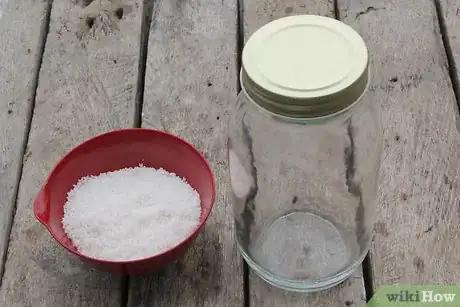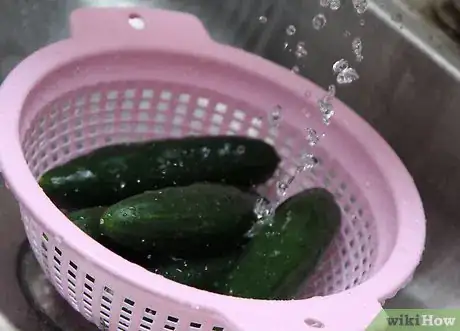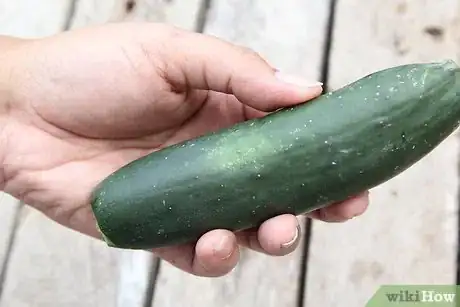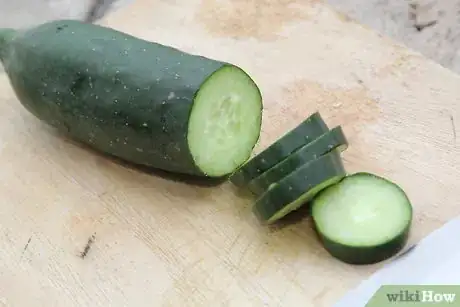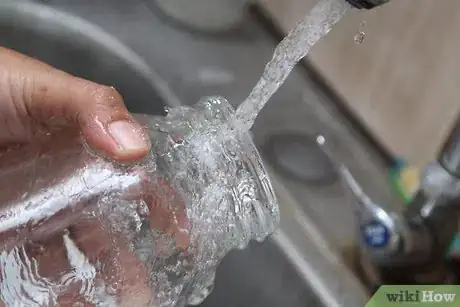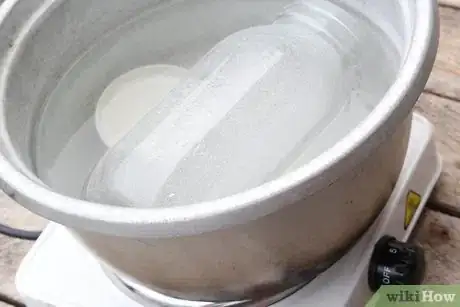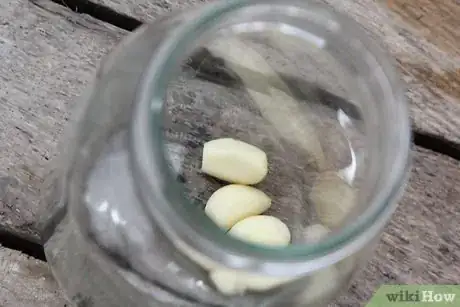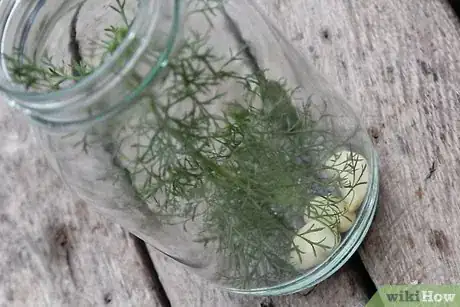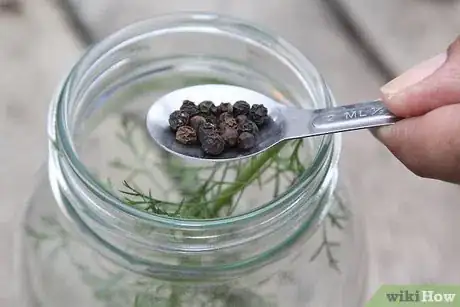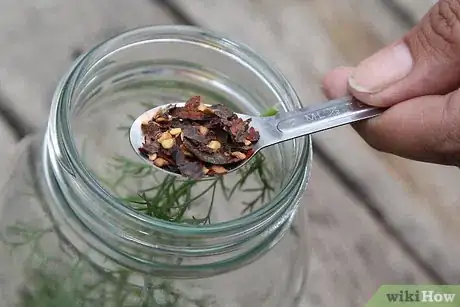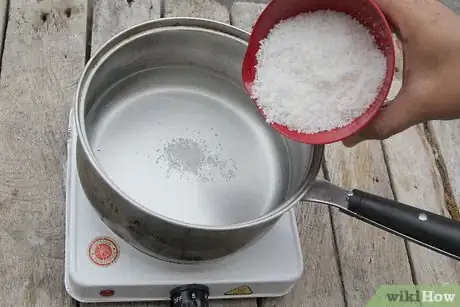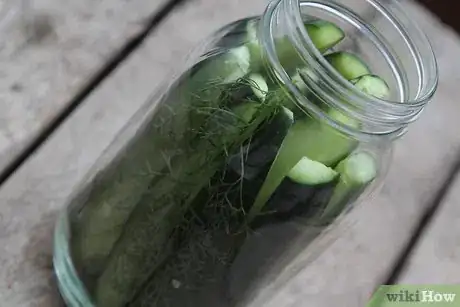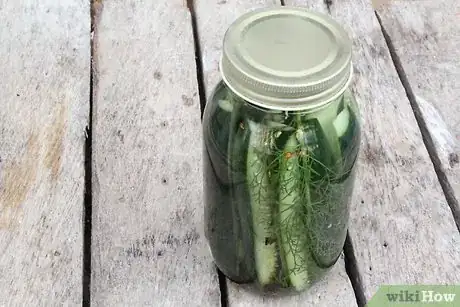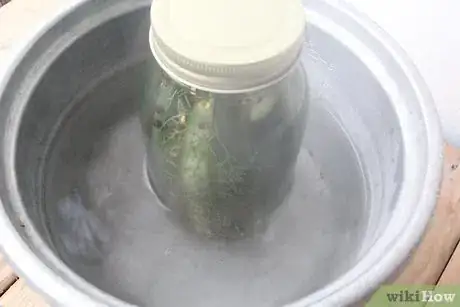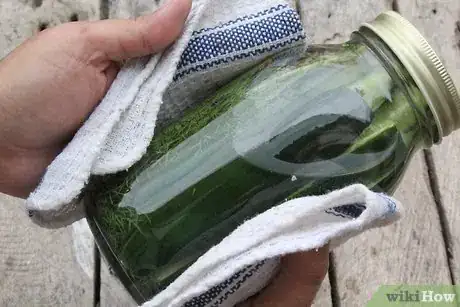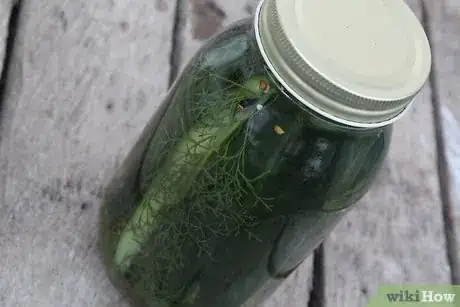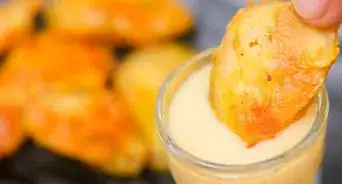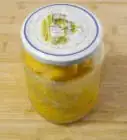X
wikiHow is a “wiki,” similar to Wikipedia, which means that many of our articles are co-written by multiple authors. To create this article, volunteer authors worked to edit and improve it over time.
This article has been viewed 200,899 times.
Learn more...
Dill pickles are a common condiment used on sandwiches, hot dogs, burgers and more. Fresh herbs and flavors, such as dill, garlic and hot peppers, are used to create a tangy taste. People who make their own pickles often have a hard time ensuring they are crunchy like store bought pickles. The process of brining and canning cucumbers can be adjusted to ensure crispier pickles. Learn how to make crispy dill pickles.
Ingredients
- Pickling salt
- Cucumbers
- Fresh dill
- Peeled garlic cloves
- Water
- White vinegar
Steps
-
1Buy canning jars and pickling salt in preparation for your pickle making. Use pint (0.47l) or quart jars (0.9l), depending upon preference; however this dill pickle recipe makes 4 pint jars of pickles. You cannot substitute table salt for pickling salt.
-
2Wash the cucumbers thoroughly. Make sure they are firm, and place any that are not aside for other uses. Dry them and refrigerate them overnight.
- For the crunchiest pickles, can your cucumbers within 24 hours after picking. Also, choose cucumbers that are 4 inches (10.2 cm) or under in length. Do not use waxed cucumbers from the supermarket.
Advertisement -
3Decide how you want to package your pickles. The following 3 choices are common for homemade dill pickles:
- If you like whole pickles, many people believe leaving them whole while canning will ensure the crispiest pickle texture.
- If you like to serve pickles on sandwiches, you may choose to slice them horizontally. They will lay flat easily on bread and can be given in smaller servings.
- If you like smaller portions and want to serve pickles on the side of meals, then quartering them vertically is a good option. Pickling in spears may sacrifice some crunchiness, but they will be better portions for most people.
-
4Wash your canning jars with soap and water to remove any food residue from the previous use. Rinse well.
-
5Sterilize the jars by placing them into warm water in a large pot or water canner. Allow the water to boil. Boil your jars and lids for 10 to 15 minutes. Carefully remove them with oven mitts and tongs.
- At elevations below 1,000 feet (305m), you should boil for 10 minutes. Add an additional minute to the boiling time for each 1,000 feet (304.8 m) of elevation after 1,000 feet (304.8 m).
-
6Place your 4 pint jars on the counter to cool. Add 3 peeled garlic cloves to each jar.
-
7Place 1 head of fresh dill in each jar. Make sure to wash and dry the dill before placing it in each
-
8Consider adding 1/2 tsp. (1.5g) of whole peppercorns and 1 tsp. (3g) of mustard seeds to each jar. Some people also like to include 1 tsp. (2g) of onion powder or some chopped fresh onions.
-
9For spicy pickles, add half a hot pepper or 1 tsp. (3g) of crushed red pepper flakes.
-
10Make your brine. Place 2.5 cups (591ml) of white vinegar, 2.5 cups (591ml) of water and 1/4 cup (59ml) of pickling salt in a saucepan. Heat until the boiling point and then remove from heat immediately.
-
11Pack as many cucumbers or cucumber sections into the pint jars as you can. You should aim to try to fill it up to the top.
-
12Pour the pickling brine over your pickles and into the pint jars. Leave only 1/2 inch (1.3 cm) of space from the top of your lid.
-
13Place your lids and rings on your pint jars.
-
14Put them in your boiling canning bath. Set the time for 5 minutes and take them out when it goes off. Do not leave them in the bath for longer than 5 minutes, or they will lose crunchiness.
-
15Wipe the pickle jars with a clean towel and let them cool before placing them in your pantry.
- Many people make "refrigerator" dill pickles. This means that they do not get a water bath and they are stored in the refrigerator before serving. If you plan to do this, place the lids firmly on the hot jars, allow them to cool on the counter and then place them in the refrigerator afterward.
- Using the water bath canning method will prevent yeast and mold from ruining pickles.
-
16Wait at least 1 week before serving, in order to allow the flavors to develop in the pickles.
Advertisement
Community Q&A
-
QuestionDo I pour the brine when it is hot or cold?
 Community AnswerBoil the brine to dissolve the salt, and pour it over the pickles while still hot.
Community AnswerBoil the brine to dissolve the salt, and pour it over the pickles while still hot. -
QuestionHow do I submerge jars when making pickles?
 Community AnswerPut water in your water bath canner and bring it to a boil before lowering the jars into the boiling water. Use canning tongs to protect your hands and to gently lower the jars into the boiling water. The water level will rise as you add jars. Make sure that you have enough water in the canner before you bring it to a boil. You can remove some water if it rises too much or you can let it overflow if you are canning outdoors in a place where the hot boiling water won't hurt anything.
Community AnswerPut water in your water bath canner and bring it to a boil before lowering the jars into the boiling water. Use canning tongs to protect your hands and to gently lower the jars into the boiling water. The water level will rise as you add jars. Make sure that you have enough water in the canner before you bring it to a boil. You can remove some water if it rises too much or you can let it overflow if you are canning outdoors in a place where the hot boiling water won't hurt anything. -
QuestionAt what point do I tighten my pickle jars when making pickles?
 Community AnswerTighten your jars after you have put all ingredients in them.
Community AnswerTighten your jars after you have put all ingredients in them.
Advertisement
Warnings
- Never change the vinegar and water proportions in the recipe. The vinegar prevents botulism if it contains 4 to 6 percent acetic acid.⧼thumbs_response⧽
Advertisement
Things You'll Need
- Canning jars
- Oven mitts
- Metal tongs
- Timer
- Canning bath
- Saucepan
- Clean towel
References
About This Article
Advertisement
